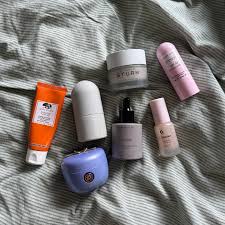
Cream Skin: The New Korean Beauty Trend for 2024
2024 has ushered in a fresh skincare phenomenon—cream skin. After the massive success of glass skin in 2023, beauty experts and enthusiasts are shifting their attention to this new, dewy, and fresh-faced skincare trend. If you’re wondering what cream skin is, how it works, and whether it’s something your skin will love, don’t worry. In this guide, I’ll break it all down for you and share how you can jump on the cream skin bandwagon.
What Is Cream Skin?
If you’re familiar with the iconic glass skin trend that dominated 2023, you know that it involved achieving a flawless, luminous finish that resembles the look of glass—clear, radiant, and hydrated to the max. This trend gained massive popularity due to its emphasis on skin health, with a multi-step skincare routine that layered lotions, serums, toners, moisturizers, and sheet masks to build a glowing complexion. Many skincare lovers embraced the meticulous routine, only to discover that it could feel a bit too elaborate and time-consuming for daily use.
Enter cream skin, a modern spin on the glass skin trend. Cream skin provides that same healthy, hydrated glow but with a significantly simplified routine that’s more realistic for people who want radiant skin without the extensive steps. The beauty of cream skin lies in its ease of achievement—no more overwhelming ten-step skincare regimens! It’s an approachable, streamlined routine designed for a more natural, radiant look.
Despite its name, cream skin doesn’t involve a thick, heavy layer of product. Rather, it’s about achieving a healthy, dewy finish that’s not overly shiny or greasy, making it an ideal alternative for those who want a low-maintenance skincare approach. This trend aligns with another growing movement in skincare: simplifying routines. With the overwhelming amount of skincare products available, many beauty lovers are looking for ways to reduce the number of products they use without sacrificing results. Cream skin fits perfectly into this shift towards minimalism in skincare.
How Do You Achieve Cream Skin?
One of the most appealing aspects of the cream skin trend is how simple it is to achieve. Unlike glass skin, which often requires multiple products and steps, cream skin boils down to just three essential stages. It’s perfect for anyone looking to streamline their routine while still enjoying glowing, moisturized skin.
Step 1: Cleanse
Begin with a gentle, creamy cleanser that doesn’t foam. The goal is to thoroughly cleanse the skin without stripping away its natural oils. Foam-based cleansers can sometimes leave skin feeling dry, but a creamy cleanser ensures your skin remains hydrated. Use a soft, warm flannel or washcloth to remove makeup, dirt, and residue, ensuring that the skin is prepped for the next steps.
A creamy, non-foaming cleanser will leave your skin feeling soft, hydrated, and ready for the next step of your routine. Be sure to remove all traces of makeup and environmental pollutants to create a clean base for the toner and moisturizer that will follow.
Step 2: Apply an Exfoliating Toner
The next step in the cream skin routine is applying a milky exfoliating toner. This product helps to remove any leftover impurities while gently exfoliating the skin, revealing a smoother, more even texture. Exfoliation is key in achieving that radiant glow, but it’s important to use a gentle, milky formula that won’t strip the skin. Apply the toner with a cotton pad, lightly sweeping it across the face, but avoid the delicate eye area.
This exfoliating toner provides a mild, effective way to prepare the skin for the moisturizing stage while maintaining the skin’s natural moisture balance. Unlike more abrasive exfoliating acids, a milky toner offers a softer, more hydrating approach, making it ideal for the cream skin aesthetic.
Step 3: Hydrate with a Lightweight Serum (Optional)
Next, you may choose to apply a serum that delivers hydration. Hyaluronic acid is a key ingredient to look for, as it draws moisture into the skin and helps keep it hydrated throughout the day. A serum containing hyaluronic acid adds an extra layer of hydration to the skin, which is crucial for achieving the dewy cream skin finish. However, if you’re feeling confident with your current hydration levels, you can skip this step.
Applying a serum is optional but highly recommended if you want an additional boost of moisture. It helps your skin retain hydration while preparing it for the final moisturizing step.
Step 4: Finish with a Lightweight Moisturizer or Balm
The final step in your cream skin routine is to use a lightweight lotion or balm. Look for products that are nourishing yet not too heavy—think moisturizers that offer deep hydration but don’t leave the skin feeling weighed down. The key is to get that dewy, hydrated glow without the heaviness that often comes with thicker creams.
One great option is a skin defense balm, which nourishes the skin without clogging pores. It’s perfect for maintaining that smooth, hydrated finish while keeping the skin breathable. The goal is to hydrate the skin deeply but avoid any overly greasy or shiny effects, as the cream skin look is a natural, subtle glow rather than the intense shine associated with glass skin.
Optional Additions: Eye Creams, Lip Care, and Face Masks
While the core cream skin routine involves just four essential steps, you can certainly add extra products if desired. Eye creams, lip balms, and moisturizing face masks are optional additions that can complement the look. However, these aren’t necessary for achieving the cream skin effect—so don’t feel obligated to use them unless you feel the need.
Makeup Application (Optional)
Once your skin is prepped and glowing with cream skin, you can choose to apply makeup, but keep it light and dewy. Avoid heavy, matte formulas and instead opt for cream-based makeup products like a CC cream, cream blush, and cream highlighter. These types of products will complement the hydrated, natural finish of your cream skin, rather than creating a stark contrast with matte or full-coverage products.
If you choose to skip makeup entirely, that’s perfectly fine! Cream skin looks beautiful and fresh on its own, so embracing your natural glow is always an option.
What Changes Will I See in My Skin with the Cream Skin Routine?
If you’re used to multi-step routines that include several products, switching to the minimalist cream skin approach may feel like a big change. However, you might be surprised at how well your skin responds to this streamlined method. With the right products, you can expect smoother, more hydrated skin that has a natural glow. The beauty of the cream skin routine is that it allows your skin to breathe, using fewer but more effective products that address your skin’s needs.
After sticking with the cream skin routine for a while, you’ll likely notice that your skin feels softer, more hydrated, and balanced. It’s perfect for those who want to keep their skincare routine simple without sacrificing results. In fact, you may even notice that your skin feels healthier and more vibrant—less is truly more when it comes to this minimalist skincare trend.
Is Cream Skin Here to Stay?
As we’ve seen with skincare trends in the past, there’s always a shift in the beauty world toward simpler, more sustainable routines. With the rise of cream skin, it seems that beauty enthusiasts are growing tired of long, drawn-out routines that require a multitude of products. Instead, many are gravitating toward a more practical and efficient approach—one that prioritizes results without the excessive number of steps.
The cream skin trend is likely to stick around in 2024 and beyond, especially as more people realize that achieving glowing skin doesn’t require a complicated, 10-step routine. By focusing on key products that deliver hydration, exfoliation, and nourishment, you can achieve a flawless, radiant complexion with far less effort.
As beauty trends continue to evolve, it will be interesting to see how this minimalist approach influences skincare routines and product development. Whether you’re drawn to natural, plant-based products or prefer scientifically advanced formulas, cream skin shows that achieving healthy skin can be straightforward and uncomplicated.
Conclusion: Simplicity and Glow with Cream Skin
Cream skin represents a shift toward simplicity in skincare while still achieving that coveted, glowing complexion. It’s a more attainable version of the glowing skin trend that dominated last year, with a focus on hydration and nourishment without overloading the skin with layers of products. By following a few simple steps, you can achieve a radiant, dewy look that’s fresh, healthy, and effortlessly beautiful.
If you’re tired of complex skincare routines or want to try something new, the cream skin trend is a great place to start. It offers the promise of glowing skin with less time spent applying products—and who doesn’t love that? Try it out for yourself and enjoy the convenience of a simple, streamlined routine that leaves your skin looking its best. Whether you go makeup-free or opt for light makeup, the cream skin look is perfect for everyday wear. Plus, you’ll have more time to savor your morning coffee, knowing that your skin is naturally glowing with minimal effort!


